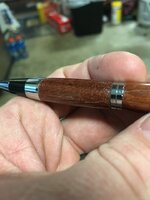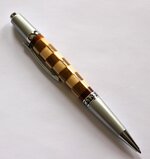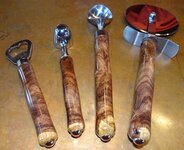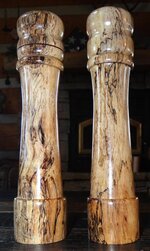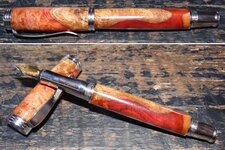Maverick KB
Member
I have been turning pens for about 2 years or so now. When I first started, I used a CA finish as that was what everyone was doing. I abandoned the CA finish a while back and for the last year have been working my own process.
1. Sanding to high grit (typically 500 or better depending on material)
2. Use sanding sealer (went through several before settling on Mylands due to clarity mostly)
3. Microcrystaline polish (as needed, often skipped)
4. Friction polish (1-3 layers)
5. Renaissance Wax
6. Buffing with microfiber cloth while still on lathe
I find this process to retain more of the natural beauty of the wood without making it look plastic. I also find that while it will wear off faster, sealing the wood first with sanding sealer (and occasionally other penetrating oils) allows for followup waxing and maintenance but still protects the wood quite well from finger oils and such.
I don't like how my earlier pens with CA finish all show scrapes, scuffs, cracks in the CA and normal wear and tear from being in the pocket or purse make the pen look horrible. Using a shellac and wax has held up quite well to pocket carry and purse carry (I keep my wife well stocked in amazing pens).
So, my question/challenge to all of you that swear by CA... Convince me. Where am I going wrong? Where have I made assumptions? Is there a way to use a CA finish that is durable against day to day use and abuse? How do I tell a client how to maintain a beautiful finish for many years with CA when they can't service it or polish it? I can suggest several furniture waxes without abrasives that will restore the luster of the original finish on my pens, but not so much with CA.
The floor is open, please educate me. Opinions are always welcome and experience is invaluable, however anything that can be backed with facts or references is appreciated (I don't mind reading and doing some research on my own too).
Thanks in advance!!
1. Sanding to high grit (typically 500 or better depending on material)
2. Use sanding sealer (went through several before settling on Mylands due to clarity mostly)
3. Microcrystaline polish (as needed, often skipped)
4. Friction polish (1-3 layers)
5. Renaissance Wax
6. Buffing with microfiber cloth while still on lathe
I find this process to retain more of the natural beauty of the wood without making it look plastic. I also find that while it will wear off faster, sealing the wood first with sanding sealer (and occasionally other penetrating oils) allows for followup waxing and maintenance but still protects the wood quite well from finger oils and such.
I don't like how my earlier pens with CA finish all show scrapes, scuffs, cracks in the CA and normal wear and tear from being in the pocket or purse make the pen look horrible. Using a shellac and wax has held up quite well to pocket carry and purse carry (I keep my wife well stocked in amazing pens).
So, my question/challenge to all of you that swear by CA... Convince me. Where am I going wrong? Where have I made assumptions? Is there a way to use a CA finish that is durable against day to day use and abuse? How do I tell a client how to maintain a beautiful finish for many years with CA when they can't service it or polish it? I can suggest several furniture waxes without abrasives that will restore the luster of the original finish on my pens, but not so much with CA.
The floor is open, please educate me. Opinions are always welcome and experience is invaluable, however anything that can be backed with facts or references is appreciated (I don't mind reading and doing some research on my own too).
Thanks in advance!!

